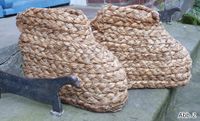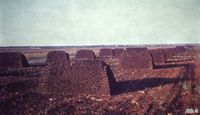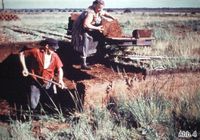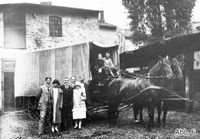Peat as an economic factor
The first energy crisis was in 1795
Shoes made of straw (Fig. 2) protected the coach drivers on their way to Braunschweig on cold days.
The new railway lines made it viable to transport coal from the Ruhr district. This had a better energy balance. This drawback could be partially compensated by compressing peat. If the fuel peat, also known as black peat or in this case pressed peat, was not dry enough, or was not to be sold until the winter, is was provisionally stored in stacks (Fig. 3). From the 1960s on, most heating systems had been converted to oil, causing peat to lose its importance as fuel.
A major employer
Heating fuel was scarce after the Second World War. Fuel peat was produced by many companies, small and large, employing more than 1500 workers. It was not until later that industrial business developed and expanded in the Gifhorn/Wolfsburg district, enabling the many refugees and displaced persons to be integrated. In the Great Moor, this was not possible without manual labour. White peat, also known as fibric peat, was cut and placed on a trolley for transportation (Fig. 4). It had to be relocated for drying (Fig. 5). Fibric peat was popular for growing flowers in gardens.
5 million horses needed peat
Before the days of cars and lorries, horses were needed for transporting people and goods. Some 5 million horses worked in Germany's cities. And they needed peat to line their stables. The Heinrich Wulfes peat works continued to supply peat to the stables of the Berlin trotting course in the 1960s. Figure 6 shows a horse and cart working for a haulage company in 1890, a common sight in those days.
No vegetables in the supermarket without peat
Like nearly all the companies in the Great Moor, the Erwin Wulfes peat press manufactured peat for soil enhancement in gardens from the 1960s. Much of the peat cutting is now performed for use in the industrial production of vegetables and potted plants (Fig. 7). Peat is perfect for use in horticulture.
Links to other stations in the museum - in English language:
<1> <2> <3> <4> <5> <6> <7> <8> <9> <10> <11> <12> <13> <14> <15> <16> <17> <18> <19> <20> <21> <22> <23>





